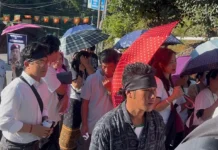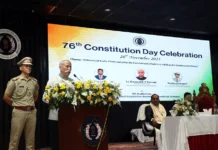[ Pradeep Kumar ]
ITANAGAR, 17 Oct: The Eaglenest Wildlife Sanctuary (EWS) in West Kameng district is considered a bird watchers’ paradise because of the abundance of winged creatures of various types, such as babblers, warblers, flycatchers, woodpeckers, and others, but it has no eagles.
Eagle as a bird species is not available in this forest. But the local people had watched personnel of the 4th Infantry Division of the Indian Army, also known as the ‘Red Eagle Division’, due to its insignia, advance in the area during the Chinese aggression in 1962.
The Red Eagle Division was deployed in the Kameng sector during the 1962 war. Members of local tribes such as Sherdukpen, Bugun and Monpa were then isolated from modern civilisation and had low literacy rates.
As the army men passed by their houses and fields, they could only identify them with their formation sign, the red eagle. The insignia was worn by all the personnel as arm patches and it was also painted on their equipment and vehicles, retired brigadier Sundar Prasad, who served the army division, later told PTI.
The insignia got imprinted in the memory of the local population and, when the time came, they named a pass ‘Eaglenest’ after it, and the area was notified as the Eaglenest Wildlife Sanctuary in 1989. The pass is within the sanctuary.
“Here lies the mystery of the name Eaglenest,” said Brig Prasad, who now lives in Guwahati.
In 1962, there was only one barely existing road connectivity between Tezpur in Assam and Tawang, bordering China, and that route was via the Eaglenest Pass, he said.
It was the Tezpur-Misamari-Thelamara-Eaglenest Pass-Tenga Valley-Bomdila-Tawang route that served as the axis of communication. Now there are other axes in the Kameng sector.
“The loss of the original axis due to disuse has also let the forest and mountain mists swallow the origin of the name, the Eaglenest Sanctuary, where the military eagles had dared the Chinese aggression,” the retired army officer said, obliquely referring to the 1968 Hollywood war film, Where Eagles Dare.
Former Thrizino-Buragaon MLA Naresh Glow named one person who had acted as a guide to take the Red Eagle Division troop to Tenga Valley through the Eaglenest Pass.
“Sambrk Glow, who was the head of Sinchung village, had shown the route to the army. He was taken to Shillong and Delhi in appreciation of his service,” he said.
Sambrk Glow died in 1989.
In 2017, the Bugun tribe declared over 17 square kilometres of their community land as the Sinchung Village Community Reserve. This acts as the buffer to the core area of the EWS.
The villagers’ efforts won them the Indian Biodiversity Award in 2018 in the conservation of wildlife species category, conferred by the National Biodiversity Authority.
Now, ecotourism has come up in a big way. This has resulted in increased employment potential. There are six local birding guides there, Naresh Glow said.
Bugun Liocichla (Liocichla bugunorum), a critically endangered passerine bird species, is found only in the EWS. The species is named after the local Bugun tribe. (PTI)




